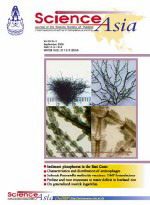ThaiScience
ThaiScience
SCIENCE ASIA
Volume 46, No. 1S, Month MARCH, Year 2020, Pages 51 - 57
Temperature dependence on structure, mechanical and electrical properties of bismuth lanthanum sodium titanate-modified lead zirconate titanate ceramics
Pharatree Jaita, Parkpoom Jarupoom
Abstract Download PDF
The effects of sintering condition on phase evolution, physical, microstructure and dielectric properties of the PZT-3BLNT ceramics were investigated. The samples were prepared by a conventional mixed oxide method and sintered at the temperatures ranging from 1050–1200 °C under normal atmosphere for 2 h dwell time with a heating/cooling rate of 5 °C/min. X-ray diffraction indicated that the mixed rhombohedral-tetragonal phases were observed at lower sintering temperature of 1050 °C, while the tetragonal phase became dominant at higher sintering temperature (1200 °C). The optimum sintering temperature for preparation of high-density PZT-3BLNT ceramic was found to be 1200 °C. Linear shrinkage and average grain size tended to increase with increasing the sintering temperature. The effects of annealing conditions on mechanical and dielectric properties of the PZT-3BLNT ceramic sintered at 1200 °C were also studied in this work. It was found that the maximum room temperature dielectric constant (εr ) of 1313 and Vickers hardness (HV) of 4.38 GPa were achieved for the sample annealed at 950 °C for 8 h dwell time and this value was ∼18–20% higher than that of the unannealed sample. This result was also well correlated with the maximum relative density observed for this annealing condition.
Keywords
sintering temperature, mechanical, microstructure, electrical properties, annealing conditionSCIENCE ASIA
Published by : The Science Society of Thailand
Contributions welcome at : http://www.scienceasia.org/
